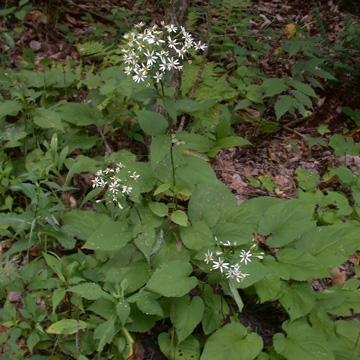

Eurybia schreberi - (image 1 of 5)
Taxonomy
Family: Asteraceae
Synonymous with Aster schreberi
Habitat
Moist to mesic woods.
Associates
Distribution
NH and southeast ME to DE and VA, west to OH and WV, irregularly to TN, AL, IL, and eastern WI.
Morphology
Rhizomatous and colonial perennial, eglandular throughout; stems 20-120 cm; basal leaves clustered, cordate, the sinus rounded, short-acuminate to obtuse, long-petiolate; middle and upper leaves gradually or abruptly reduced, becoming sessile and ovate to lanceolate or elliptic; inflorescence corybiform, puberulent, few-bracted; involucres 5-10 mm, often narrow; involucral bracts narrow, sometimes a little loose, those of the inner row longer than the rest; rays 6-14, white.
Notes
Flowers: July to October
Wetland indicator: NA
Closely resembles E. macrophylla which usually has bluish rays rather than the white rays of E. schreberi. Pale flowered forms of the former can be distinguished by its stipitate-glandular involucral bracts and lower leaf surfaces. The bracts of E. schreberi are at most only sparsely stipitate-glandular and the lower surface of its leaves are merely villous and eglandular.
References
Gleason, Henry A. and A. Cronquist. 1991. Manual of Vascular Plants of
Northeastern United States and Adjacent Canada. Second Ed.
The New York Botanical Garden. Bronx, NY
|
Michael Hough © 2018 |